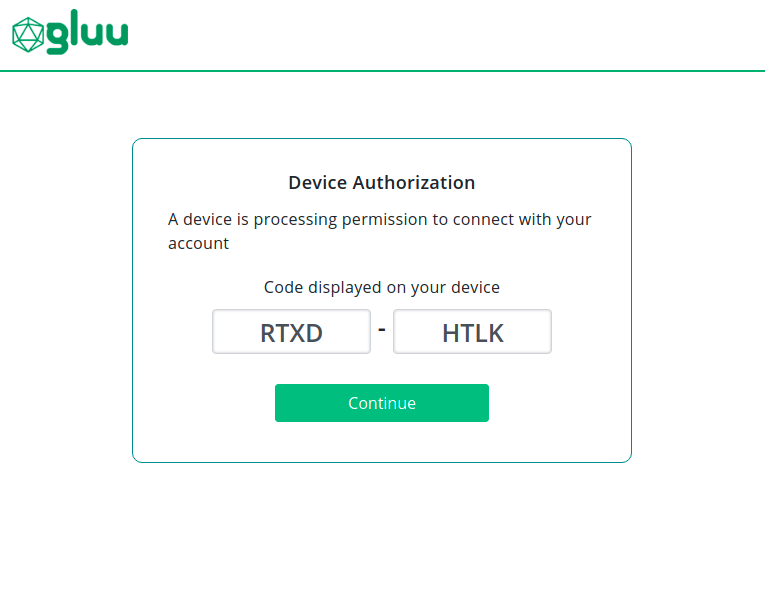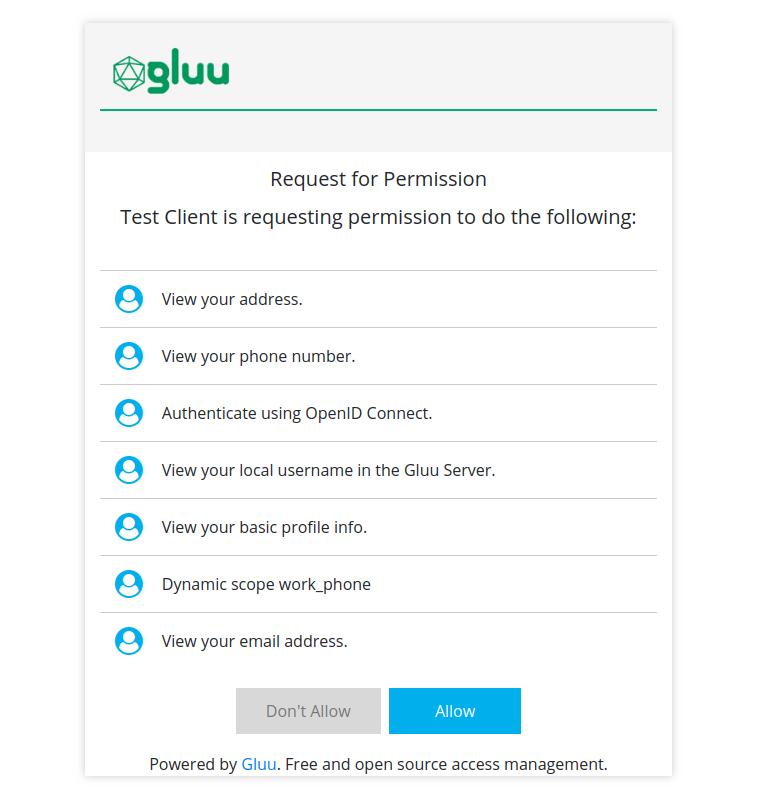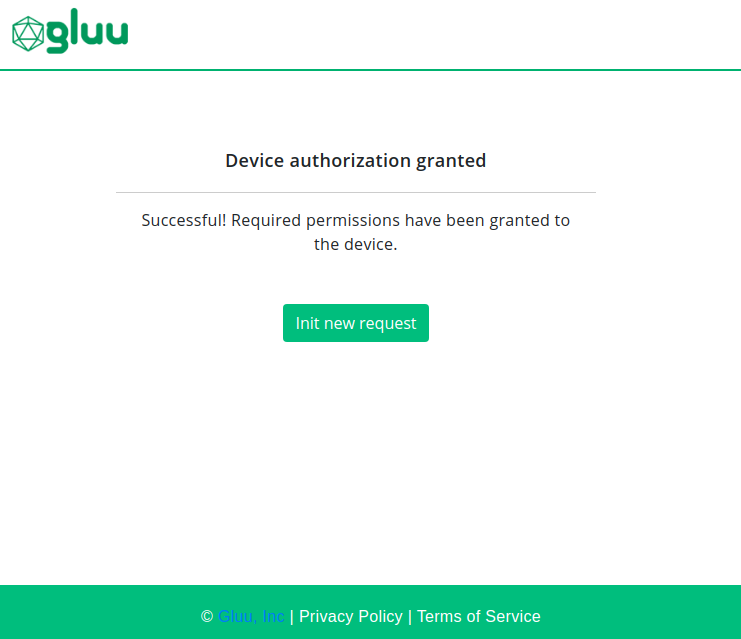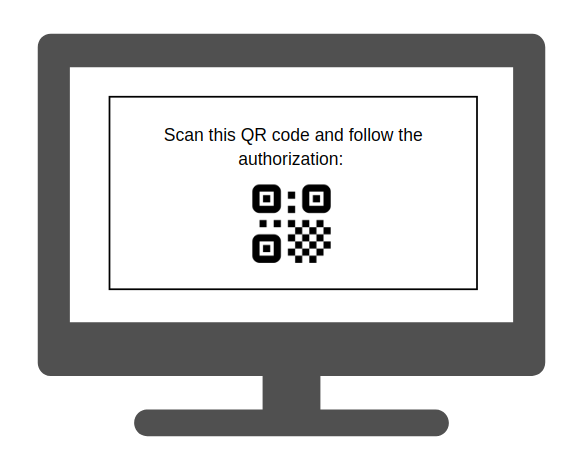OAuth 2.0 Device Authorization Grant#
Signing into apps and services on devices such as smart TVs, media consoles, printers and others can be difficult to process, since those kind of devices don't have rich interfaces to process a whole authorization flow, in these cases this grant type tries to use another agent like a browser in a computer or a smartphone.
This OAuth 2.0 protocol extension enables OAuth clients to request user authorization from applications on devices that have limited input capabilities or lack a suitable browser. The authorization flow defined by this specification, sometimes referred to as the "device flow", instructs the user to review the authorization request on a secondary device, such as a smartphone, which does have the requisite input and browser capabilities to complete the user interaction.
Specs are written in RFC8628
User Experience#
First, the user requests authorization from the device:

At the URL displayed on the screen, the user can input the displayed code in the device.

After that, user could need to authenticate, then decide whether permissions will be granted.

Finally, the confirmation screen will be shown.

How it works#
This flow is processed between the device and another richer user-agent like the browser. Different messages are sent to the authorization server between them.

The flow has the following steps:
- Device sends a reuqest to Gluu authorization server that identifies the scopes that the application will request permission to access.
- Gluu server responds with different fields used in the following steps, mainly
user_codeanddevice_code. - Device displays
user_codeandverification_urlto the user. - User should open
verification_urlusing a different user-agent like a web browser from a computer, login and authorize. - Device continuously requests the token from Gluu server every N seconds until server has a result, it could be many results like:
access_denied,expired_token,authorization_pendingor it could be also the token generated when user grants the permissions.
Request user and device codes#
This first step, device sends an HTTP POST request to Gluu authorization server, at /oxauth/restv1/device_authorization which is also presented in the Discovery url published by Gluu Server, this endpoint could process a common authentication method or it could also not do any authentication, depending on the configuration for the client in Gluu Server.
Parameters#
| Parameter | Description |
|---|---|
| client_id | Required The client ID for your application. |
| scope | Required A space separated list of scopes that identify the resources that the device could access on the user's behalf. These values inform the consent screen that Gluu server displays to the user. |
Example#
POST /restv1/device_authorization HTTP/1.1
Content-Type: application/x-www-form-urlencoded
Host: test.gluu.org
Authorization: Basic MTIzLTEyMy0xMjM6WkE1aWxpTFFDYUR4
client_id=123-123-123&scope=openid+profile+address+email+phone
Device Request response#
In response, the Gluu authorization server generates a unique device verification code and an end-user code that are valid for a limited time and includes them in the HTTP response body using the "application/json" format with a 200 (OK) status code. The response contains the following parameters:
| Parameter | Description |
|---|---|
| user_code | Required The end-user verification code |
| device_code | Required The device verification code |
| verification_uri | Required The end-user verification URI on the authorization server. This should be shown to the end-user because he should open this url in the rich user-agent. |
| verification_uri_complete | Optional This is similar than verification_uri, however it also includes user_code as a query param in the url. It's issued if the device wants to use QR mode for example. |
| expires_in | Required The lifetime in seconds of the device_code and user_code. |
| interval | Required The minimum amount of time in seconds that the client should wait between polling requests to the token endpoint. |
Example:#
HTTP/1.1 200
Content-Length: 307
Content-Type: application/json
Server: Jetty(9.4.19.v20190610)
{
"user_code": "SJFP-DTPL",
"device_code": "aeb28bdc90d806ac58d4b0f832f06c3ac9c4bd03292f0c09",
"interval": 5,
"verification_uri_complete": "https://test.gluu.org:8443/device-code?user_code=SJFP-DTPL",
"verification_uri": "https://test.gluu.org:8443/device-code",
"expires_in": 1800
}
Device Display#
Common flow, the device should display verification_url and user_code received from Gluu server. The content that the device displays to the user should instruct the user to navigate to the verification_url on a separate device and enter the user_code.
Design device interface following these rules:
-
user_codehas the following format: XXXX-XXXX where Xs represent to any ASCII character, for example: RTXD-HTLK. The length of theuser_codewill be always the same, therefore it's highly recommended to show it as clear and big that the user can read it easly. -
verification_urlshould be displayed also in a way that the user can read it easily. The normal length should be around 40 characters, however it could depends also on the domain used for the server. Remember that the user will need to write the whole URL manually in the web browser, therefore it's recommended to use a short URL. -
verification_url_completewill be used for those cases where device can show QR (Quick Response) codes or NFC (Near Field Communication) to save the user from typing the whole URI. Interaction between device and Gluu server will be the same, however user can process the authorization faster. For example:

User Login & Authorization#
The user will need to put user_code value in the browser and after that, he will be redirected to the common authorization flow, it requires login whether there is no session between the user-agent and the Gluu server and grant the permissions based on the device request.
Poll Token#
Since the user will be using a separate device to navigate to the verification_url and grant or deny access, the requesting device is not automatically notified when the user responds to the access request. For that reason, the requesting device needs to poll the Gluu Server to determine when the user has responded to the request.
The requesting device should continue sending polling requests until it receives a response indicating that the user has responded to the access request or until the device_code expires. The parameter interval returned in step 2 specifies the amount of time, in seconds, to wait between requests.
The URL of the endpoint to poll is /oxauth/restv1/token. The polling request contains the following parameters:
Parameters#
| Parameter | Description |
|---|---|
| client_id | Required The client ID for your application. |
| grant_type | Required Must be urn:ietf:params:oauth:grant-type:device_code. |
| device_code | Required The device verification code which is returned by Gluu server in Step 2. |
Authentication can be done using any of those authentication methods for this token endpoint.
Example:#
POST /restv1/token HTTP/1.1
Content-Type: application/x-www-form-urlencoded
Host: test.gluu.org
Authorization: Basic MTIzLTEyMy0xMjM6WkE1aWxpTFFDYUR4
grant_type=urn%3Aietf%3Aparams%3Aoauth%3Agrant-type%3Adevice_code&device_code=0bd7068e7fdab4bb91b313296a96462256a7370d12f073f0
Token Response#
The Gluu authorization server responds to each polling request with one of the following responses:
Access granted
If the user granted access to the device (by clicking Allow on the consent screen), then the response contains an access token and a refresh token. The tokens enable the device to access to the resource server on the user's behalf.
In this case, the server responds with all tokens required and allowed to be issued depending on the configuration in the server.
Example:
HTTP/1.1 200
Content-Length: 858
Content-Type: application/json
Server: Jetty(9.4.19.v20190610)
<<<<<<< Updated upstream
{"access_token":"c31fc092-453b-4275-a36f-b2740c3eb1a6","id_token":"eyJraWQiOiJlY4.2Tc4NDgxYy05OTJkLTRmN2UtYTkzMS03NjM2NTYyMzgwZjVfc2lnX3JzMjU2IiwidHlwIjoiSldUIiwiYWxnIjoiUlMyNTYifQ.eyJhdF9oYXNoIjoidWdMSnAzMkxXdnI4QUdlbmdNTlF3QSIsImF1ZCI6IjEyMy0xMjMtMTIzIiwic3ViIjoiM2M2M25HdWZnWFNkMWFwNU81NFZkVjlUUDdmdjJHc0YtLWl0eVBHeFJBTSIsImlzcyI6Imh0dHBzOi8vdGVzdC5nbHV1Lm9yZzo4NDQzIiwiZXhwIjoxNTk1NjQzOTg0LCJpYXQiOjE1OTU2NDAzODQsIm94T3BlbklEQ29ubmVjdFZlcnNpb24iOiJvcGVuaWRjb25uZWN0LTEuMCJ9.fElZtuUslhSSuqTOuvGeafG4QuQoHKLpya25RHWkC5V9Xf9ODYa6tD_Tdav2D9Gff2Zz7pt8WKso-WYOqmJ3NrgMoVU7d1SMj6pYGilTL1JokjB18Yw1TI6oR6Z4wegy8_ajftLLhqosI5-ZE36TzPwoAKzjPl-iZEpV2U1OPHWZrdwc9N3YOyO0I_IJGQmFnXC_oacitMV2VZaTxfuCew5cPwNp5durooFNvv3DPzc9JYEctmaLsiRtfqN7pCaV30B3hnYTYZ4p2HNsUbOewBI8_Brm1v1CByitQPUFqETgmPGbf4HCTEoaH-7DfaXnAsePt73blNwJrlTlUBieew","token_type":"bearer","expires_in":299}
Access denied
If the user refuses to grant access to the device, then the server response has a 400 HTTP response status code. The response contains the following error:
HTTP/1.1 400
Cache-Control: no-store
Content-Length: 74
Content-Type: application/json
Pragma: no-cache
Server: Jetty(9.4.19.v20190610)
{
"error_description": "access_denied",
"error": "access_denied"
}
Authorization pending It means that the request hasn't been processed by the end-user yet, therefore the request is still in process.
Example:
HTTP/1.1 400
Cache-Control: no-store
Content-Length: 90
Content-Type: application/json
Pragma: no-cache
Server: Jetty(9.4.19.v20190610)
{
"error_description": "authorization_pending",
"error": "authorization_pending"
}
Polling too frequently
If the device sends polling requests too frequently, then the server returns a 400 HTTP response status code. Then the device should increase the time interval between requests.
Example:
HTTP/1.1 400
Cache-Control: no-store
Content-Length: 66
Content-Type: application/json
Pragma: no-cache
Server: Jetty(9.4.19.v20190610)
{
"error_description": "slow_down",
"error": "slow_down"
}
Other errors
This token endpoint can return any error code already defined, for example whether client can't be authenticated or the grant type sent is invalid. Some of them could be: invalid_client, invalid_grant, invalid_request and others.